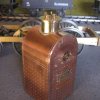John
Yes, the fact that I'd made it a little too wide was a bit annoying. I managed to save the door and have fitted it to a new backhead. I've also made a new throat plate together with the boiler mounting ring. The wrapper is complete too. I need to make the square end nuts, that are actually the ends of the longitudinal stays, before I solder on the wrapper, and I can't see that happening this side of Christmas. The front and rear plates for the smokebox have been formed but, I need to make the opening and the doors before that can be soldered together.
So, there has been some progress but nothing solid just a box of parts waiting for further work.
Jon
















